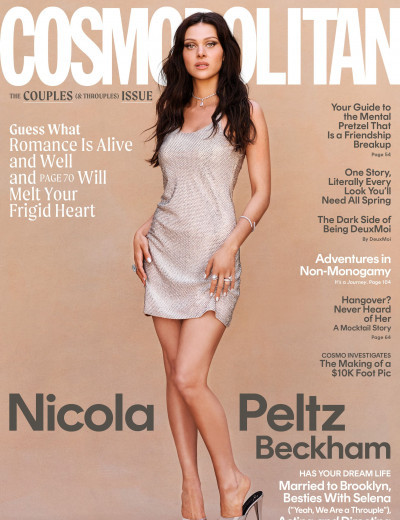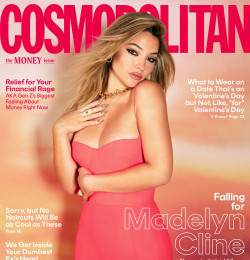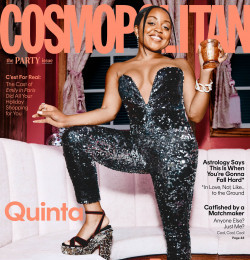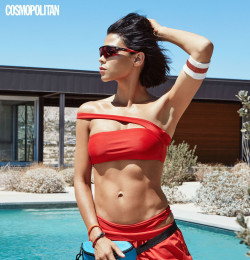Cosmopolitan USA


Cosmopolitan is an international magazine for women. It was first published in 1886 in the United States as a family magazine, was later transformed into a literary magazine and eventually became a women's magazine in the late 1960s. Also known as Cosmo, its current content includes articles on relationships and sex, health, careers, self-improvement, celebrities, as well as fashion and beauty. Published by Hearst Magazines, Cosmopolitan has 58 international editions, is printed in 34 languages and is distributed in more than 100 countries.
History
Cosmopolitan began as a family magazine, launched in 1886 by Schlicht & Field as The Cosmopolitan.
Paul Schlicht told his first-issue readers that his publication was a "first-class family magazine", adding, "There will be a department devoted exclusively to the interests of women, with articles on fashions, on household decoration, on cooking, and the care and management of children, etc., also a department for the younger members of the family."
Cosmopolitan's circulation reached 25,000 that year, but by March, 1888, Schlicht & Field were no longer in business. John Brisben Walker acquired the magazine in 1889, and E. D. Walker, formerly with Harper's Monthly, took over as the new editor, introducing color illustrations, serials and book reviews. It became a leading market for fiction, featuring such authors as Annie Besant, Ambrose Bierce, Theodore Dreiser, Rudyard Kipling, Jack London, Willa Cather and Edith Wharton. The magazine's circulation climbed to 75,000 by 1892.
In 1905 William Randolph Hearst purchased the magazine for $400,000 (approximately $11,000,000 in 2007 prices) and brought in journalist Charles Edward Russell, who contributed a series of investigative articles, including "The Growth of Caste in America" (March, 1907), "At the Throat of the Republic" (December, 1907 - March, 1908) and "What Are You Going to Do About It?" (July, 1910 - January, 1911) and "Colorado - New Tricks in an Old Game" (December 1910).
Other contributors during this period included Alfred Henry Lewis, Sinclair Lewis, A. J. Cronin, David Graham Phillips, George Bernard Shaw, Upton Sinclair and Ida Tarbell. Illustrators included Francis Attwood, Dean Cornwell, James Montgomery Flagg and Harrison Fisher.
With a circulation of 1,700,000 in the 1930s, Cosmopolitan had an advertising income of $5,000,000. Emphasizing fiction in the 1940s, it was subtitled The Four-Book Magazine since the first section had one novelette, six or eight short stories, two serials, six to eight articles and eight or nine special features, while the other three sections featured two novels and a digest of current non-fiction books. During World War II, sales peaked at 2,000,000.
The magazine began to run less fiction during the 1950s. Circulation dropped to slightly over a million by 1955, a time when magazines were overshadowed during the rise of paperbacks and television. The Golden Age of magazines came to an end as mass market, general interest publications gave way to special interest magazines targeting specialized audiences.
Helen Gurley Brown arrives
Cosmopolitan's circulation continued to decline for another decade until Helen Gurley Brown became chief editor in 1965 and remodeled the magazine as New Cosmopolitan.After countless denials by other publications, Brown finally landed an opportunity to put a unique perspective on a tiresome magazine meant for both men and women. The magazine was renamed back to Cosmopolitan in 1967. In the early 1970s, Cosmopolitan became a women's magazine. The magazine eventually adopted a cover format consisting of a usually young female model typically in a low cut dress or bikini. The magazine focused on young women and published articles that openly talked about sexual issues.
Her uproar of a magazine was not her first publication dealing with sexually liberating woman. In fact, she first wrote a book in 1962, Sex and the Single Girl, which instantly became a best seller. Identical to her magazine Cosmopolitan, this novel focused on a sexually fearless single lady who dates many men. Fan mail begging for Brown’s advice on many subjects concerning women’s behaviorisms, sexual encounters, health, and beauty flooded her front door after this book released. Brown sent the message to the books fans stating how a woman should have men complement her life; not take it over. Enjoying sex without shame was also an empowering message she incorporated in both publications.
In Brown's early years as editor, the magazine received heavy criticism. The magazine ran a near-nude centerfold of actor Burt Reynolds in April 1972. The issue created great controversy, propelling Cosmopolitan to the forefront of American popular culture at the time.
In April 1978, a single edition of Cosmopolitan Man was published as a trial, targeted to appeal to men. Its cover featured Jack Nicholson and Aurore Clément. It was published twice in 1989 as a supplement to Cosmopolitan.
Cosmopolitan today
In recent years the magazine and in particular its cover stories have become more sexually explicit in tone as well as covers with models wearing revealing clothes. Kroger, America's largest grocery chain, currently covers up Cosmopolitan at checkout stands because of complaints about sexually explicit headlines. Walmart, Wegmans, and other retailers do this as well.
The UK edition of Cosmopolitan, which began in 1972, was well known for sexual explicitness, with strong sexual language, male nudity and coverage of such subjects as rape. In 1999, CosmoGIRL!, a spinoff magazine targeting a teenage female audience, was created for international readership. However, it ended print production in December 2008.
Real-world stories are recounted ("Real Life Reads") first-hand by survivors, safety tips for risky or dangerous situations (such as living alone) accompany stories of hidden risks, health myths and urban legends are debunked. Sections such as "Health Check", which has featured articles such as "Cosmo Gyno" and "Your Body: What An Abnormal Pap Smear Can Mean", are there not only for entertainment value but to help women understand their bodies and even recognize possible health problems. Less serious regular features include "Guy Confessions" (pages where men share embarrassing stories or shameful things they've done); celebrity gossip; "You, You, You", which contains a wide variety of fun facts and advice.
The magazine currently features topics such as sex, makeup and hair tips.
Cosmopolitan has readers in more than 100 countries and offers editions, both published by Hearst and/or a licensing partner in 34 languages, including Finnish, Spanish, Korean, Hungarian, Bulgarian, Portuguese, Swedish, Polish, Hebrew, Estonian, Romanian, Georgian, Russian, German, Italian, French, Greek, Malaysian and Indonesian. It was banned in Singapore until recently.
Cosmopolitan has traditionally been a women’s magazine discussing such topics as sex, health, fitness and fashion. Recently the magazine is sharing their focus with men’s issues as well. “Cosmo for your guy” is featured in every issue with exclusive advice for the men. Cosmopolitan also recruits men as a part of their staff to answer their female readers' burning questions they just can’t ask the men in their lives. The “Guy Confessions” add men’s embarrassing mishaps to those submitted by women.
It should be noted, that when the season's issues stack up chronologically, the spines of the magazine reveal a typical Cosmo-guy lounging on your shelf.





